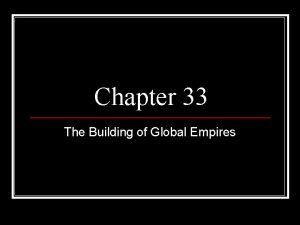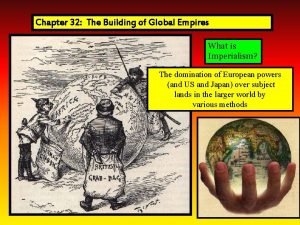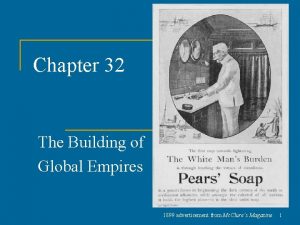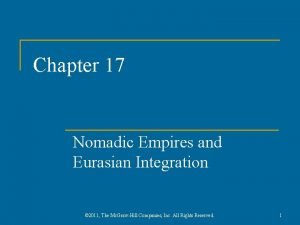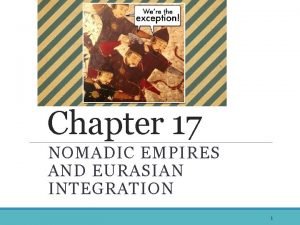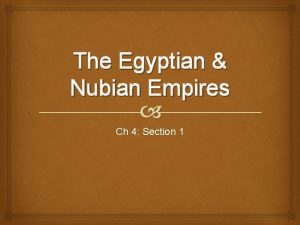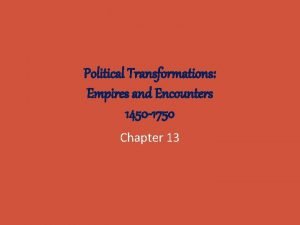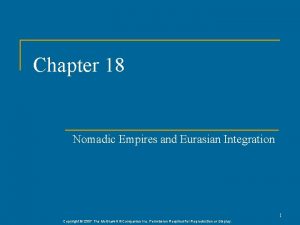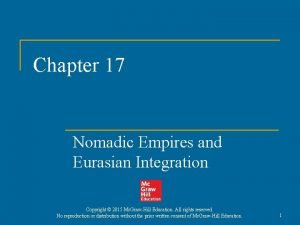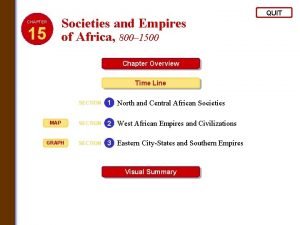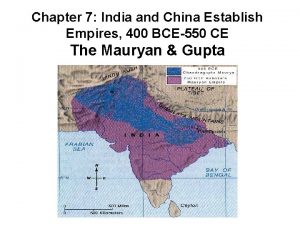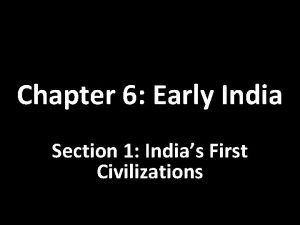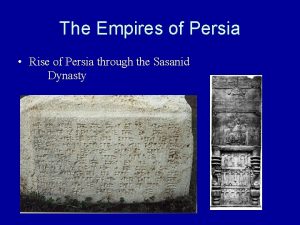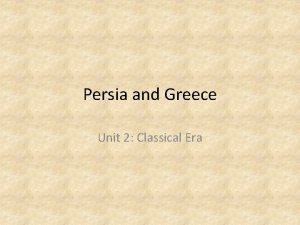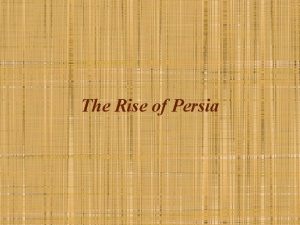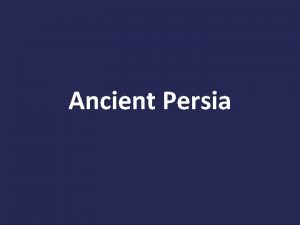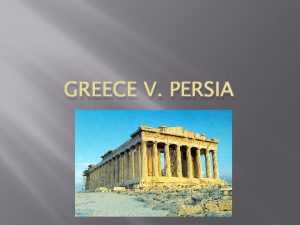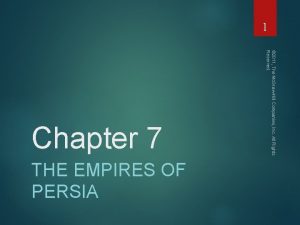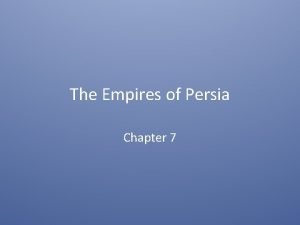Chapter 7 The Empires of Persia 2011 The


















- Slides: 18

Chapter 7 The Empires of Persia © 2011, The Mc. Graw-Hill Companies, Inc. All Rights Reserved. 1

Persian Empires n n Contemporary Iran Four major dynasties q q Achaemenids (558 -330 B. C. E. ) Seleucids (323 -83 B. C. E. ) Parthians (247 B. C. E. -224 C. E. ) Sasanids (224 -651 C. E. ) © 2011, The Mc. Graw-Hill Companies, Inc. All Rights Reserved. 2

Achaemenid Empire (558 -330 B. C. E. ) n Migration of Medes and Persians from central Asia, before 1000 B. C. E. q n n Capitalized on weakening Assyrian and Babylonian empires Cyrus (r. 558 -530 B. C. E. ) founder of dynasty q n Indo-Europeans “Cyrus the Shepherd” Peak under Darius (r. 521 -486 B. C. E. ) q q Ruled Indus to the Aegean Capital Persepolis © 2011, The Mc. Graw-Hill Companies, Inc. All Rights Reserved. 3

Achaemenid Administration: The Satrapies n n n Twenty-three administrative divisions Satraps Persian, but staff principally local System of spies, surprise audits q n n Minimized possibilities of local rebellion Standardized currency for taxation purposes Massive road building, courier services © 2011, The Mc. Graw-Hill Companies, Inc. All Rights Reserved. 4

Technologies n Qanat: System of underground canals q n Avoided excessive loss to evaporation Extensive road-building q Persian Royal Road n q 1600 miles, some of it paved Courier service © 2011, The Mc. Graw-Hill Companies, Inc. All Rights Reserved. 5

Decline of the Achaemenid Empire n Policy of toleration under Cyrus, Darius q n n Rebuilding of temple in Jerusalem Xerxes (486 -465 B. C. E. ) harshly represses rebellions in Mesopotamia and Egypt Increasing public discontent © 2011, The Mc. Graw-Hill Companies, Inc. All Rights Reserved. 6

Persian Wars (500 -479 B. C. E. ) n n Rebellious Greeks in Ionia Peninsular Greeks join in Persians defeated at Marathon (490 B. C. E. ), retreated Alexander the Great conquers the Achaemenid empire (334 -331 B. C. E. ) © 2011, The Mc. Graw-Hill Companies, Inc. All Rights Reserved. 7

Seleucid Empire n n n Alexander the Great dies suddenly Generals divide empire, best part goes to Seleucus (r. 305 -281 B. C. E. ) Attacked by rebellion in India, invasion of Parthians © 2011, The Mc. Graw-Hill Companies, Inc. All Rights Reserved. 8

The Achaemenid and Seleucid Empires, 558 -330 B. C. E. and 323 -83 B. C. E. © 2011, The Mc. Graw-Hill Companies, Inc. All Rights Reserved. 9

Parthian Empire n n n Seminomadic Parthians drive Seleucus out of Iran Federated governmental structure Especially strong cavalry Weakened by ongoing wars with Romans Fell to internal rebellion © 2011, The Mc. Graw-Hill Companies, Inc. All Rights Reserved. 10

Sasanid Empire (224 -651 C. E. ) n n Claimed descent from Achaemenids Continual conflicts with Rome, Byzantium in the west, Kush in the east Overwhelmed by Arab conquest in 651 Persian administration and culture absorbed into local Islamic culture © 2011, The Mc. Graw-Hill Companies, Inc. All Rights Reserved. 11

The Parthian and Sasanid Empires, 247 B. C. E. -651 C. E. © 2011, The Mc. Graw-Hill Companies, Inc. All Rights Reserved. 12

Persian Society n Early steppe traditions q q n Warriors, priests, peasants Family/clan kinship very important Creation of bureaucrat class with empire q q q Tax collectors Record keepers Translators © 2011, The Mc. Graw-Hill Companies, Inc. All Rights Reserved. 13

Slave Class n n Prisoners of war, conquered populations Debtors Children, spouses also sold into slavery Principally domestic servitude q Some agricultural labor, public works © 2011, The Mc. Graw-Hill Companies, Inc. All Rights Reserved. 14

Persian Economy n n n Several areas exceptionally fertile Long-distance trade benefits from Persian road-building Goods from India especially valued © 2011, The Mc. Graw-Hill Companies, Inc. All Rights Reserved. 15

Zoroastrianism n n n Early Aryan influences on Persian religious traditions Zarathustra (late seventh to early sixth century B. C. E. ) Prophet of Ahura Mazda, against Angra Mainyu Priests of Zarathustra known as magi Oral teachings until Sasanid period composed Gathas © 2011, The Mc. Graw-Hill Companies, Inc. All Rights Reserved. 16

Fortunes of Zoroastrianism n n Under Alexander: massacre of magi, burning Zoroastrian temples Weak Parthian support Major revival under Sasanids, persecution of non-Zoroastrians Discrimination under Islam © 2011, The Mc. Graw-Hill Companies, Inc. All Rights Reserved. 17

Other Religious Groups in the Persian Empire n n Major Mesopotamian communities of Jews Composition of the Talmud, ca. 500 C. E. q n “Constitution of Judaism” Buddhism, Christianity and Manichaeism also survived © 2011, The Mc. Graw-Hill Companies, Inc. All Rights Reserved. 18
 Maritime and land based empires differences
Maritime and land based empires differences Chapter 33 the building of global empires
Chapter 33 the building of global empires Chapter 32: the building of global empires
Chapter 32: the building of global empires Chapter 32 the building of global empires
Chapter 32 the building of global empires Chapter 17 nomadic empires and eurasian integration
Chapter 17 nomadic empires and eurasian integration Nomadic empires and eurasian integration
Nomadic empires and eurasian integration Chapter 19 islamic gunpowder empires
Chapter 19 islamic gunpowder empires Chapter 4 section 1 the egyptian and nubian empires
Chapter 4 section 1 the egyptian and nubian empires Chapter 5 political transformations empires and encounters
Chapter 5 political transformations empires and encounters Chapter 27 the islamic empires
Chapter 27 the islamic empires Chapter 27 the islamic empires
Chapter 27 the islamic empires Chapter 18 nomadic empires and eurasian integration
Chapter 18 nomadic empires and eurasian integration Chapter 17 nomadic empires and eurasian integration
Chapter 17 nomadic empires and eurasian integration Chapter 16 people and empires in the americas
Chapter 16 people and empires in the americas Chapter 33 the building of global empires
Chapter 33 the building of global empires Chapter 15 societies and empires of africa
Chapter 15 societies and empires of africa Chapter 7 section 1 india's first empires
Chapter 7 section 1 india's first empires Chapter 7 india and china establish empires
Chapter 7 india and china establish empires Chapter 7 section 1 india's first empires
Chapter 7 section 1 india's first empires

